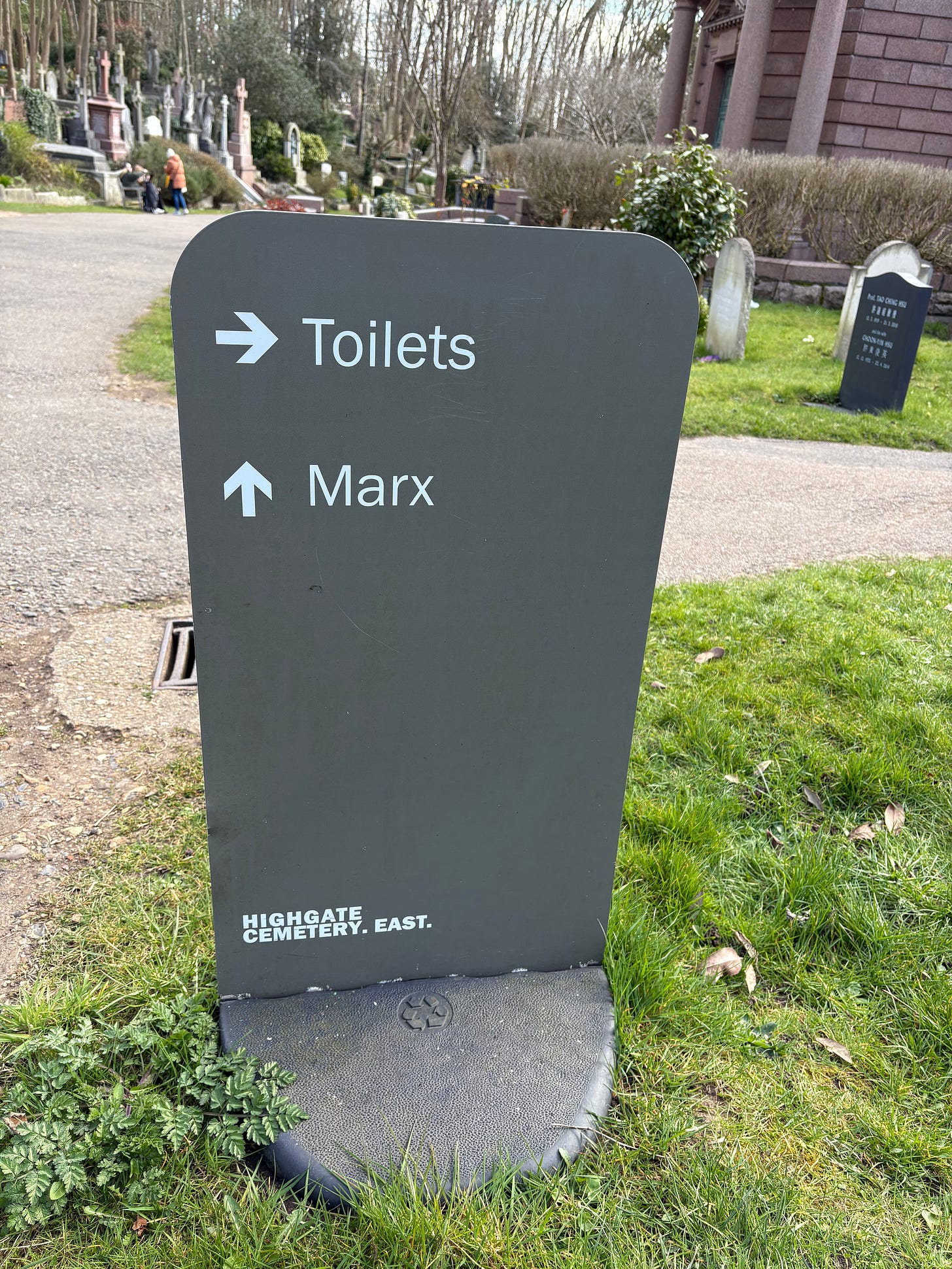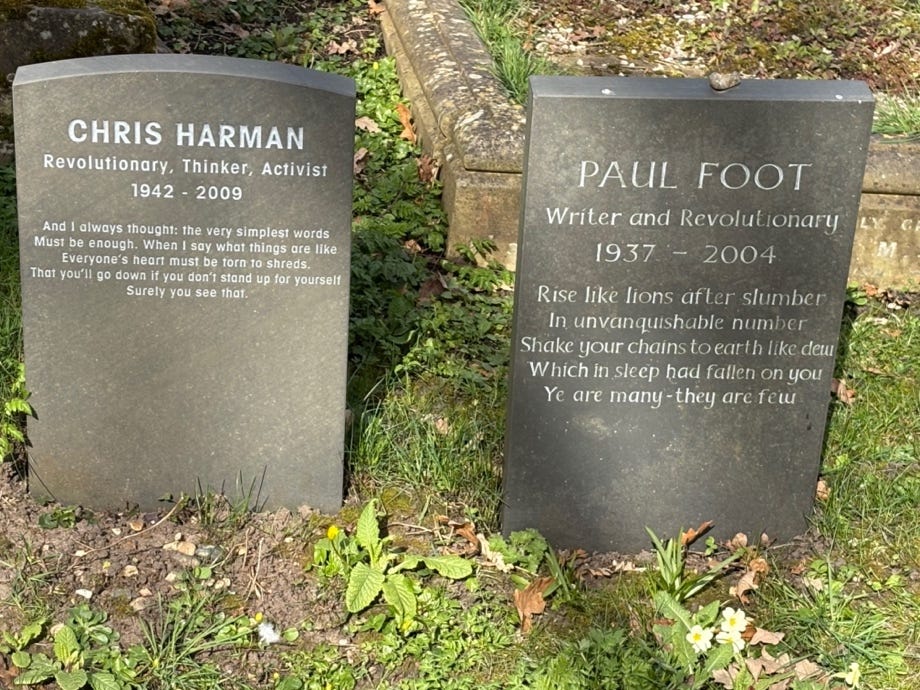The Endgame
Newsletter #99 - A visit to Highgate Cemetery
Toronto, March 23, 2025
A visit to Highgate Cemetery
Cemeteries are a map of death. How are the gravestones and memorials placed? What company must the dead keep? There is much to divine.
Last week my wife and I were in London. One morning, while Cynnie was off doing something else, my beloved English cousin Gillian suggested a visit to Highgate Cemetery. It was unusually cold for the middle of March, cloudy and wet, with gusts of bitter wind. In the cemetery clumps of daffodils heralded spring, but the trees were bare. As we wandered through the graveyard, the sun occasionally broke through and warmed our bones.
Highgate Cemetery, like Pere La Chaise in Paris which inspired it, is a private garden cemetery open to all denominations. The West side, opened in 1839, is beautiful in a gloomy, gothic sort-of-way. Many of those interred there were members of the 19th century upper middle classes who pursued traditional careers in the army or church. Some even entered the world of commerce. There is a smattering of writers (e.g., Beryl Bainbridge, Radclyffe Hall) and artists (George Hering, Frank Holl).
In little snippets the eccentric Visitor Map tells us a bit about some of the West side’s inhabitants. Lord Cheylesmore was “the first British peer to be killed in a car accident.” Charles Cruft was “Founder of the famous dog show. According to his wife, he preferred cats.” George Wombwell “Became a household name as owner of three large travelling animal shows.”
Unexpectedly, the West side also houses Russian dissident Alexander Litvinenko, murdered in 2010 by Russian agents using Polonium-210. Singer-songwriter George Michael, who died in 2016, is also buried there. (This reminds me that the most visited grave in Pere La Chaise is not Frédéric Chopin or Marcel Proust, but Jim Morrison, front man of The Doors).
The East side of Highgate, across Swains Lane from the West side, is an 1860 extension of the original cemetery. A no-nonsense sign at the entrance to the East side clearly identifies its highlights.
More interesting than Marx’s brutalist tomb is the cluster of revolutionaries and trouble-makers huddled together in its shadow, as if seeking Marx’s approbation and protection. Yusuf Dadoo, South African communist and anti-apartheid activist. Mansoor Hekmat, Iranian Marxist theorist. British Marxist historian Eric Hobsbawm. Paul Foot, writer and revolutionary. Saad Saadi Ali, Iraqi communist leader. Chris Harman, revolutionary, thinker, and activist.
I particularly liked the epitaph on Harman’s tombstone, which reads in part: “And I always thought the very simplest words/ Must be enough. When I say what things are like/ Everyone’s heart must be torn to shreds...” (These are lines from Berthold Brecht’s poem, The Solution.)
On the East side there’s someone for everyone. Douglas Adams, author of The Hitchhiker’s Guide to the Galaxy, is buried there. So is Ann Jewson Crisp, who died in 1884 (“Had a faithful dog, Emperor,” so the Visitor Map tells us). George Eliot (simply described by the Map as “Novelist” – no mention of Middlemarch). The mysterious Jim Horn (“Avid reader but not a partner in the firm”). Bruce Reynolds (“Mastermind of the Great Train Robbery in 1963”). Edward Woodham (“Soldier who survived the charge of the Light Brigade”).
My favourite epitaph on the East side is Malcom McLaren’s: “Better a spectacular failure, than a benign success.” McLaren was manager of the Sex Pistols and made a film called The Great Rock ‘n’ Roll Swindle.
Getting back to Karl Marx, his body may lie in Highgate Cemetery but otherwise he lives on. The week before going to London I took this picture on an Italian train:
It was nice, for once, to see someone reading a book.
Note to readers: There won’t be an Endgame next week. I’ll be in Nova Scotia packing up our house there. After almost 30 years of happy summer living by the beach, we’ve sold the place. I’ll write something about that in the next Endgame which, by the way, will be the one hundredth edition of the newsletter.







Philip, you are an impassioned and even scholarly docent to wonderful cemeteries, but your report on Highgate is especially splendid. In 2007, with the help of a translator named Michiko Zento, I visited 46 burial shrines of Japanese writers. Ginko trees, cuckoos, astonishing flower arrangements--- Basho's was perhaps my favorite, the Akutagawa Ryonosuke's (He wrote the story "Rashomon") had a certain likeness to Jim Morrison's in Paris; for the 35 year old suicide, there were vials of veronal, graffiti, all sorts of art work, and a life-size sculpted portrait made of
cardboard and elegantly painted, under an umbrella. Even here in Vermont, the anxiety-winds of fascism blow in from our nation's capital. I have never been more closely in touch with Canadian friends, some friendships of 55 years now. Make no mistake about it, Elon Musk gave a Nazi salute. Our beloved Senator Bernie Sanders is drawing anti-Oligarch crowds of tens of thousands. Between my family and the families of my friends there is no border. Howard Norman
Really appreciate your writing and your humanity, especially in these times! Thank you!